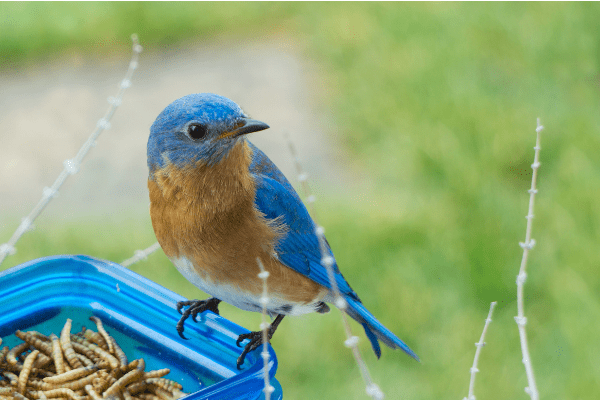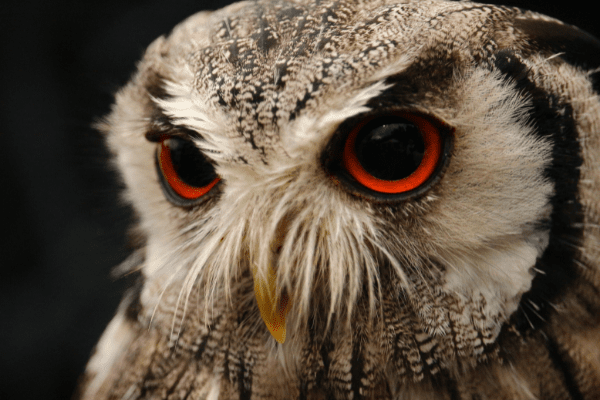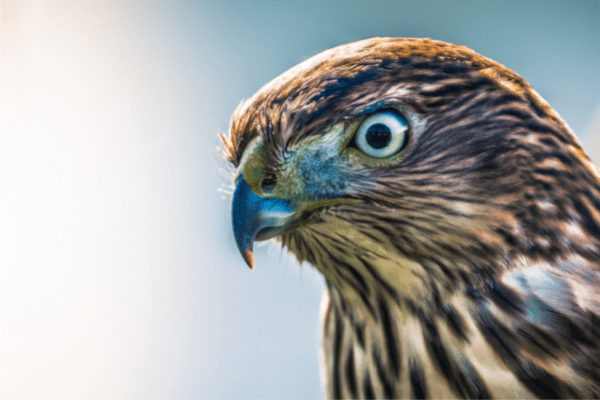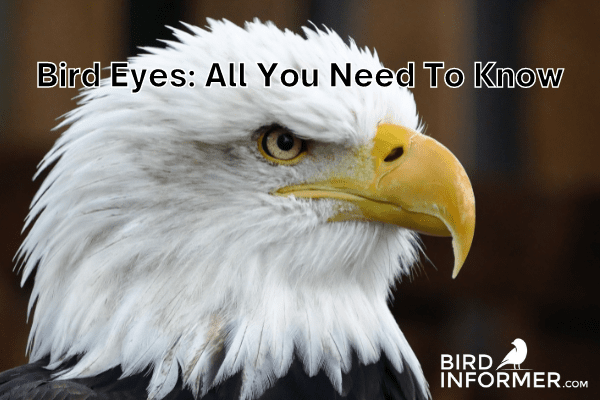Many of us have tried to sneak up and corner a bird in the past, only for them to fly away without even looking directly at us. Bird eyes are some of the most amazing eyes in the animal kingdom.
Knowing how their eyes work is crucial if you want to take up bird watching as a hobby.
Why?
If you want to find a great bird-watching spot without disturbing any birds, you’ll need to be out of plain sight.
Birds have large eyes that allow them to see and process images much faster than humans. They even have enlarged pupils that can give them excellent vision even in dim light and nighttime.
Of course, understanding the abilities and limits of a bird’s eyes is much more complicated than that. Lucky for you, we’ve created an article that will break down all the information you need to know.
In this guide, we’ll explain everything you need to know about the eyesight of birds.
Why Do Birds Have Large Eyes?
Like most animals, birds have eyes that are specially designed for their lifestyles.
Some of the most common reasons why bird eyes tend to be larger include:
Bird’s Living Environment:
Just like humans live in different environments with varying levels of light and darkness, birds also live in many different lighting conditions.
Birds who fly at night need large and bright eyes so they can properly see and avoid obstacles. Birds who hunt on the open sea will have special adaptations that allow them to see prey even when there is no light shining on the surface of water.
Tendency to Hunt Prey:
Most birds feed on insects, fish, or other small rodents that tend to stay close to where it is dark and hard to see. If birds wanted to catch their prey, they needed larger eyes that could pick up on smaller movements in dim light or nighttime.
Where Do They Live:
Not all birds live in the same environments. Some prefer living near water because fish become easier to spot when close to the surface of water.
Others prefer living in open lands where it is easy for them to hunt small rodents without having to use much energy.
Related article: In The Eyes Of An Owl: Why Are They So Big?
How Do Bird Eyes Work?
Most people don’t really know how birds can see so well in dim light or at night.
The truth is, the way a bird’s eyes work isn’t all that different from our own.
A bird will look at an object with both of its eyes and figure out where the object is located based on the slightly different images that each eye picks up.
Since birds often use their eyes to find prey, they also have excellent depth perception too.
Birds are able to judge distances more accurately than us because they typically view objects with both of their eyes instead of just one like humans do.
Using stereoscopic vision, they can determine if something is close enough to be eaten or if it’s far away enough to be ignored.
Additionally, birds have retina cells with a thin layer of tissue that reflects light back to the eye. Even in areas with low light, this helps them pick up on subtle movements in their environment.
The reflective tissue also improves the image quality in dim lighting conditions by allowing more light to enter the eyes.
This is important because it gives them an advantage when hunting for prey during nighttime or when they are flying at dawn or dusk when there’s less available sunlight.
We Know How Bird Eyes Work…What About Their Brains?
Contrary to popular belief, birds are actually very smart. Click the button below to learn about bird brains!
What Science Understands About Bird’s Brains: They Might Be Smarter Than You ThinkHow Do Birds See Colors?
Most humans have three types of color-sensitive cone cells within our retinas. These special cells help us identify what color something is even if it looks gray or black and white under normal lighting conditions.
Birds also have these types of cells, but they also have a fourth cone that is sensitive to color.
This ability helps them see more colors and shades allowing them to be more aware of their surroundings during nighttime or when it’s cloudy which makes it harder for us humans to see.
Birds who live in areas with harsh sunlight can also use this extra cone receptor as an advantage. For example, birds living near the equator have been known to develop cone cells that are sensitive to ultraviolet light.
This allows them to easily find food that tends to appear brighter under UV lighting conditions.
Bird Eyes FAQs:
To help you learn more about how a bird’s eyesight works, we’ve included some FAQs you can review.
Can All Birds See the Same Colors?
Not all bird species have the same capabilities when it comes down to seeing colors.
Birds who live in high altitudes or cold climates may not have the same types of cone cells as birds living near the equator, but they can still see a wider range of colors.
In addition to that, some birds also have two different types of cone cells that contain ultraviolet light receptors instead of just one type like other bird species with four cones do.
Other bird species only have one type of color receptor and rely on their ability to use different wavelengths of light to help them better see certain objects based on their surroundings.
What Colors Can Birds See?
The average human being is able to recognize around 10 million colors while some people are even known to be able to recognize close to 100 million colors. Hummingbirds are known to be the only species of bird that can see ultraviolet light.
As a result, they have been known to favor certain types of flowers that contain more UV markings on them since these flowers will appear brighter and bigger than other flowers that don’t have any UV coloring.

How Well Can Birds See?
Birds often use their eyesight to hunt for food or find shelter during nighttime or when it’s cloudy outside. Because of this, their eyesight is incredibly important for their survival.
Hummingbirds are especially known for having excellent vision despite being so small in size.
The average hummingbird has an equal acuity level as an owl despite not actually being able to move its eyeballs as most birds can do.
In fact, the hummingbird has been known to have an acuity level that is as close to four times sharper than what humans have.
Falcons and eagles are also known for having excellent vision, but they aren’t quite as good as the hummingbird when it comes to sharpness.
Their eyes can make out objects from up to two miles away which gives them plenty of time to prepare before attacking their prey.
What Can Birds See in Slow Motion?
Bird’s eyes move much more rapidly than our own do and they’re able to see in slow motion allowing them to catch all of the details when flying through trees or looking at certain objects in their surroundings.
Their eyes also take in much more light than our own eyes do which allows them to see more clearly even under low-light conditions.
What Do Birds See When It’s Dark?
Birds’ eyes are incredibly sensitive to any type of light that may be available including green, yellow, and orange colors during nighttime or when it’s cloudy outside.
Their eyes also don’t have a complete color-blind spot like ours do. Humans lose the ability to see certain colors when they’re in dimly lit areas because there isn’t much available light for our cone cells to capture.
Cone cells just can’t function without having plenty of photons that are needed to create an image on the retina. Because of this, many times humans will lose their color vision when it’s dark out unless they’re wearing special glasses that allow them to see certain colors.
Birds on the other hand still have all of their color vision capabilities even when it’s dark outside.
They rely on their cone cells to help them see objects in dimly lit areas just like we do with our rods which are responsible for helping us make out silhouettes of items around us.
So, what do birds see when it gets really dark?
Because bird eyes are so much more sensitive to available light, they can see at incredible levels of brightness without having any problems seeing things clearly.
This means even when there is no light at all, birds will be able to pick up on some small amount of light that allows them to see objects more clearly.
The different colors that birds can actually see may be dependent on what species of bird they are and what types of cones they have in their eyes.
How Sharp is a Bird’s Peripheral Vision?
Birds’ peripheral vision is incredibly sharp even when they’re flying at high speeds which allows them to see all of their surroundings without having to turn their head or body.
Their eyes are located on the side of their heads so it only makes sense that they would be able to see objects around them without actually needing to look directly at them.
Even birds with monocular vision can still pick up on objects in their surroundings without turning their heads because of their ability to see slightly out of the corner of their eye at all times.
Their peripheral vision will allow them to keep track of where certain predators may be hiding while also seeing what types of prey may pass by them near enough for them to make a successful attack if needed.

How Does a Bird’s Vision Protect Them from Predators?
Birds have excellent vision that allows them to be able to see certain predators coming from a mile away.
Their eyes can pick up on certain movements in their surroundings and birds are also known for being able to notice certain colors, shapes, and differences in brightness which helps them avoid being preyed upon by other animals.
As you can imagine, this has helped many birds survive long enough to actually reproduce and pass down their genes throughout the generations.
How Do Birds See in Flight?
Many birds like woodpeckers who don’t migrate will use their sharp vision in flight to keep track of where they’re going while flying at incredibly fast speeds.
Their vision will help them maneuver through trees without having to break their neck trying to see where they’re going while also being able to see predators that may be lurking in the trees or near enough for an attack on them.
Birds’ eyes are perfectly designed for seeing during flight with both monocular and binocular vision allowing them to have a clear view of what is coming at them or up ahead of them which helps them avoid dangerous collisions with anything else.
What Do Birds See During Winter?
Birds that migrate during winter will use their eyesight to help them navigate to warmer climates where they can find enough food to survive.
Different types of birds have different ways of seeing things while migrating which actually has a profound effect on where they fly throughout the seasons.
They often will require excellent vision in dimly lit areas like migratory songbirds who need good night vision when it gets dark out.
These types of birds rely on their sense of sight more than others do during all seasons.
This is because it’s incredibly important for them to be able to see what is around them whenever they’re flying at high speeds or even when they’re resting and waiting for the right time to fly away.

Do Birds Have Any Limits to Their Eyesight?
Birds are known for having incredibly good eyesight regardless of their species which makes them excellent hunters and adapted to living in many different places.
Their full range of vision allows them to be able to spot dangers coming at them while also being able to see food that may be nearby or what types of predators may be looking for trouble where they live.
However, some birds have small eyes that don’t reflect light nearly as well as others. Kiwis are an example of nearly-blind birds with this type of defect.
Learn More About Bird Behaviors
Birds have excellent eyesight that can help them in certain situations, such as hunting and foraging. Birds’ eyes work much like ours but are more powerful and accurate.
Again, understanding this science will help tremendously if you plan on watching any birds without disturbing them in their natural habitats.

from BirdInformer.com https://ift.tt/gBfxpvU

No comments:
Post a Comment